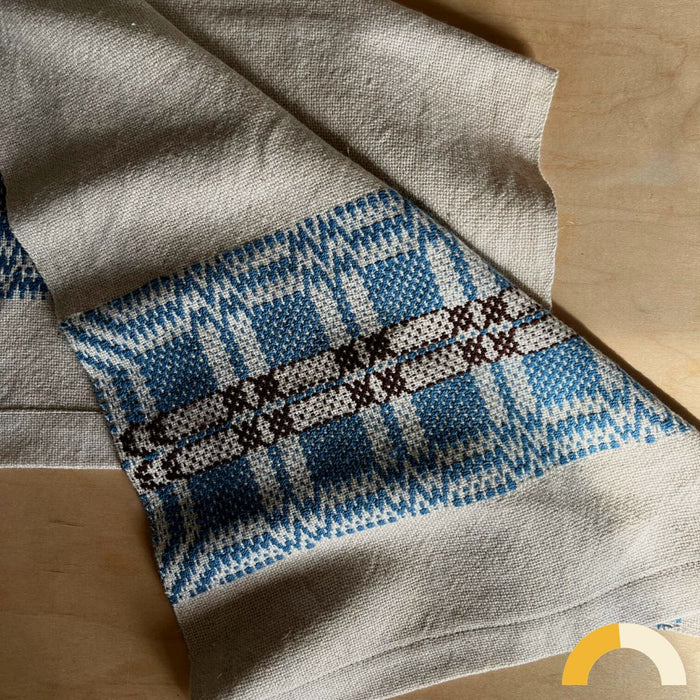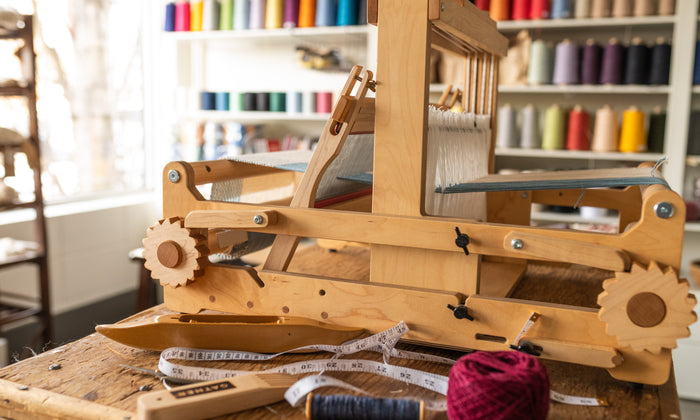Wool is...
an incredible fibre: natural, beautiful, breathable, and biodegradable, perfect for making warm, durable clothes, blankets, and more. If you’re planning to join the company of weavers who have been using wool for millennia, here are some things to consider:
1. Keep your end product in mind
With any project, so much depends on how you’re planning to use what you create! A hardy camping blanket and an airy spring wrap will require different choices about yarn, sett, and structure. Having a clear sense of what characteristics you’re aiming for will help you make choices along the way. Does your wool need to be next-to-skin soft? How much warmth are you hoping for? When it doubt, go back to your purpose and see what fits.
2. Choose strong warp
Wool can absolutely be used for both warp and weft, but not all wool is equally suitable for warp. Warp yarn needs to be strong, hold up under tension, and resist abrasion from the reed. Smooth yarn that has at least two plies is the safest bet for warp. Watch out for wool ‘singles’--single ply yarns that are very soft, but often pull apart under tension. They make great weft, but should be avoided as warp unless they have very high twist. Wool spun ‘thick and thin’ can also cause problems in the warp if the thicker sections are wide enough to catch on heddles or in the reed. To see if a wool is good for warp, take each end of a foot-long piece in either hand and pull firmly for several seconds. Wool that drifts apart will not make good warp. If it passes this test, run the yarn through the heddles and reed you are planning on using to make sure it can move freely. There’s nothing worse than setting up a whole warp only to have it end up breaking under tension or fraying in the reed!
3. Watch your count
The count system used for wool is not the same as the count system used for cotton, which is also different from the count system used for linen. Wool yarn of a given count is heavier than similarly labelled cotton and finer than similarly labelled linen. I know, I know, it’s like they’re just trying to make our lives difficult. Your best bet is always to use a sett checker or refer to a sett chart to see how other weavers have used that same count. If you’re using wool marketed to knitters, check out our Weaving for Knitters post for a handy knitting-to-weaving translation guide.
4. Meet the Sheep
Just like there are different breeds of dogs, there are different breeds of sheep. Each breed produces its own characteristic wool. You’ve likely heard of merino, a popular sheep breed that is plentiful in the southern hemisphere and produces soft, snuggly wool. Blueface Leicester (BFL) sheep are prized for their long-staple, lustrous fibre and raised in Europe and North America. Here in Alberta, local spinners make yarn from local Finn, Dorset and Rambouillet sheep, among others! If you’re interested in using local wool or just want to feel less lost when shopping for yarn, reading up a bit about sheep breeds is helpful and fascinating.
5. It’s not finished til it’s wet finished
Like all natural fibres, wool will change substantially when washed (superwash wool is an exception–more on that below). Wool expands, binds to neighbouring threads, and softens in a process called ‘fulling’. Fulling is essentially controlled partial felting. This process is absolutely essential to producing stable, touchable wool cloth. We recommend a vigorous handwash with plenty of soap (any detergent will do) in warm water. It can feel scary agitating wool, but the cloth really does need it! Go slow and stop when your cloth becomes stable and no longer shifts when you give it a hard press with a finger. It really does transform your work.
6. Leave some breathing room
The process of fulling wool needs room to happen. Often when beginner weavers try wool for the first time, they worry that the grid they are weaving has far too much empty space to produce stable cloth. The ends per inch and picks per inch required by patterns seem too low to work! But once the cloth is fulled, those spaces fill in with fluffy fibres. Be sure to leave some breathing room in your weaving as you go so that this can happen. Too tight a sett or too firm a beat can produce an end result that is prickly and dense. If the fibres don’t have room to expand, they can force their way out any direction they can, creating itch-inducing projects.
7. Fluff it up or Flatten it out
Speaking of those fluffy fibres, if you want to add a fuzzy halo to your woven woolens you can give them a good brushing after wet finishing! I use a bristle brush that’s dedicated for use on scarves only. Lay your damp weaving on a flat surface. Using one hand to hold the weaving in place, brush firmly along the surface in all directions: up, down, and from the center out to each side. Work in about 8-inch sections until you’ve brushed your full piece.
On the other hand, if you want your wool to be sleek and smooth, a good hard press with an iron will do wonders. Just use the ‘wool’ setting to avoid accidental felting!
8. To Superwash or not to Superwash
Of course, very little of this applies if you’re using superwash wool! Superwash wool is chemically treated to smooth the fibres so that they won’t felt… but this means it also won’t full. You can wet finish a piece woven with superwash wool for as long as you’d like with very little change to the yarn. Can you weave with superwash? Absolutely you can! But your pieces will not gain the added stability, body, and fluffiness that comes from fulling. Brushing won’t do much to it, either. We choose untreated wool whenever we can because we don’t want to miss out on the benefits of wet finishing. If you have a superwash stash you’re itching to weave through, try using a slightly denser sett than you normally would or using a textured weave structure to make up for the lack of fulling.
9. Mix and match
Wool is wonderful on its own, but it also plays nicely with other fibres. We love using wool as a weft on cotton warps for some added fluff and warmth. Wool is also a popular pattern weft for overshot pieces on a cotton ground. Or you could warp with your wool and use bamboo or silkpaca for weft to add slinkiness and drape to a shawl. And of course wool goes well with wool blends! Just avoid combining superwash and untreated wool in the same piece–they shrink at dramatically different rates and can make a piece curve and pucker.
10. Put your wool to work!
Sometimes we think of wool as being a fussy fibre because we can’t toss it in the wash. While it does need to be hand-washed, it doesn’t need to be babied! Wool is hardy, moisture-wicking, and naturally resistant to odor. Wool should be worn, snuggled under, and taken into the great outdoors. When you do wash your woolen pieces, you can use a specialty detergent if you’d like. There’s really no need to, though! A gentle handwash in cold water with whatever soap you use for the rest of your laundry will do just fine. Wool can last a lifetime when cared for. Which is a good thing, considering all of the blood, sweat and tears that go into a weaving project!
We hope you’ll love working with wool. It’s such a beautiful, useful, versatile natural fibre that it belongs in every weaver’s stash. Stay cozy and happy weaving!








